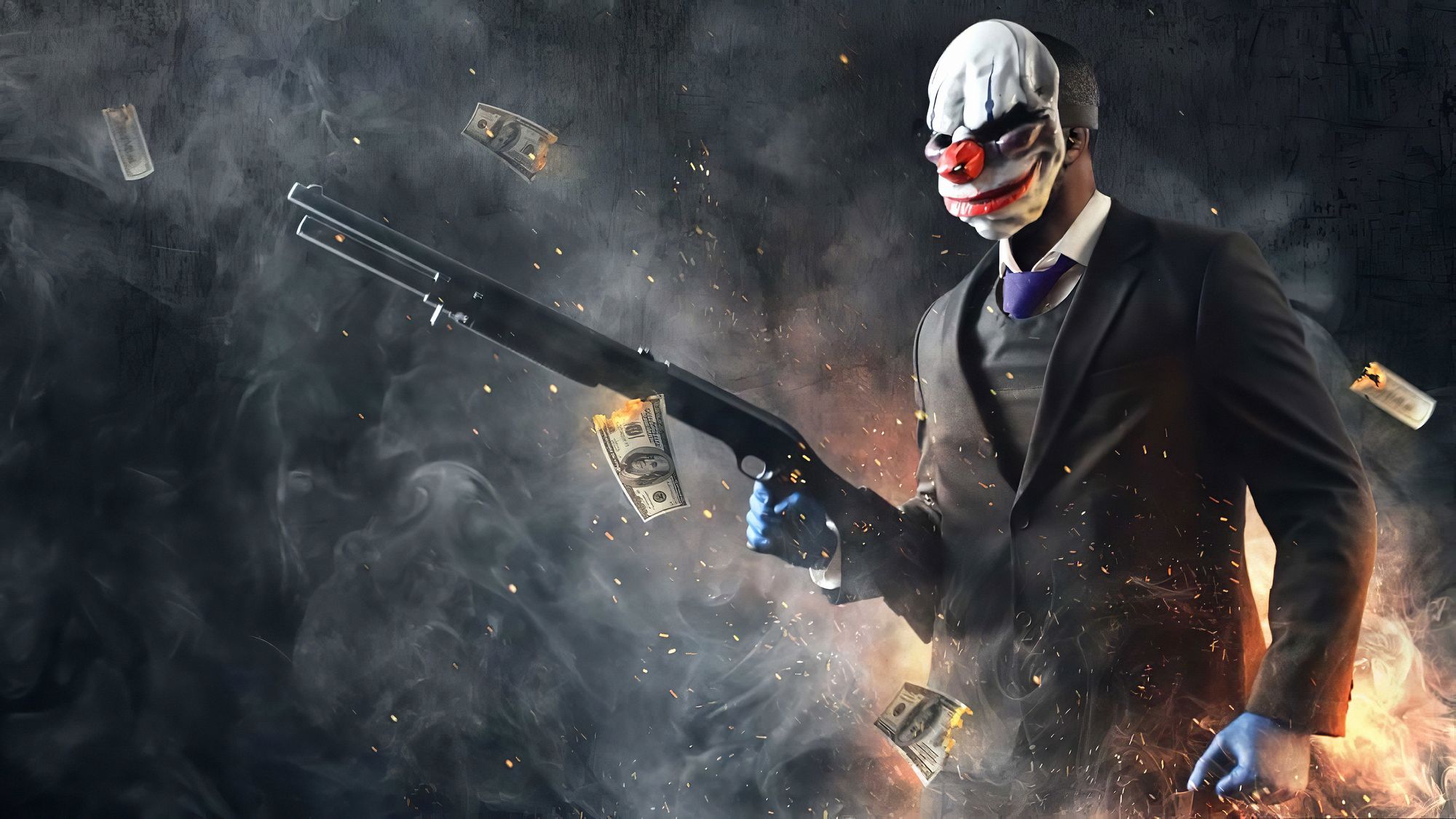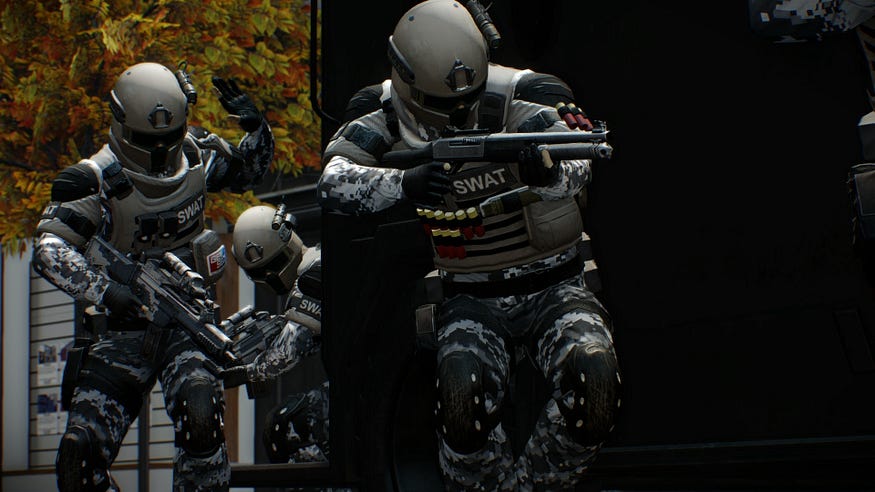Payday 2: So Much More Than Heists
Bursts of calculated chaos make up the fun in Payday 2

It may lack polish, but Payday 2’s dynamic gameplay and peerless customization made it an endlessly replayable co-op shooter.
At first glance, Overkill Software’s Payday 2 may not leave a good impression. The game may look like the typical cops-and-robbers simulator where you play as the robber, a theme explored in numerous games before and after this one.
Playing through it for a bit probably won’t help either. It’s clear that the game is plagued with unwieldy gameplay mechanics, outdated presentation, and uneven voice performances. And who can forget the game’s abysmal driving mechanics despite running on a racing game engine?
But once players manage to get past all of the game’s shortcomings, they will find that there is much to love about the game, be it in the gameplay or the personalization options.

The Heist
Let’s start from the surface: despite the game’s marketing, missions (known as heists) in Payday 2 involve more than just bank heists. Some heists involve players making away with other valuable loot, such as gold bullion or drug contraband. Some heists deviate from a typical ‘heist’ formula entirely, with players participating in prison breaks, VIP escorts, or even assassinations.
There is a good variation of heists to choose from, each with their own tactics usually falling into three categories: stealth-only, loud-only, or a hybrid of the two. The amount of diversity in the heists contributes to keeping the game from becoming stale, although their execution can be hit or miss, as some heists are better designed and less tedious than others. Still, with more than 70 to choose from, there is something for every type of heister out there.
Gameplay in Payday 2 is dynamic and ever-evolving to players’ actions. Unlike heavily scripted games such as Grand Theft Auto V and Red Dead Redemption 2, most heists do not have fail conditions, except when the player dies by way of getting downed too often.

This incarnation of dynamic gameplay may not be readily visible in loud-only or stealth-only heists; loud-only heists rarely have objective-fail scenarios in them, while triggering the alarm in a stealth-only heist will immediately lead to the heist fail screen. It is when the game combines the two elements that the dynamic gameplay mechanics kick in.
Players start their loud-stealth hybrid heists in stealth mode, completing stealth objectives while avoiding detection from security guards and/or civilians. If the alarm is triggered, the heist will adapt accordingly to players’ actions by changing its objectives to those of the loud counterpart. In some heists, however, objectives can adapt depending on when exactly players fumble the heist’s stealth section.
Let’s draw from one of the game’s most meticulous bank heists, codenamed “The Big Bank”. During the heist, players are supposed to start the time lock to a massive security gate that leads to the bank’s security center. Beyond this lies the bank’s vault, which can be accessed via a combination of a fingerprint scanner, another timelock, and a keypad. The code to initiating the first-time lock can be acquired by one of two methods: getting it from the bank’s server room, or if that fails, from one of the employee computers. All of these objectives are to be completed in stealth.
Multiple loud scenarios can emerge from these stealth objectives. If players are detected before starting the gate time lock, the heist will instead instruct players to re-wire the time lock under gunfire while waiting for an enormous vault drill to be dropped through the bank’s skylight in a giant piggy-bank. However, if players are detected after opening the security gate, the heist will instead fast-track immediately to dropping the piggy-bank without the need to hack the employee terminals.
The Tunes
Complementing the dynamic nature of the heists is the BGM, which is as dynamic as the gameplay itself with a large variety in style. Unlike most games where a specific track is assigned to a specific mission, Payday 2 players are allowed to mix and match different tracks from different heists. That being said, all heists have their own uniquely hard-hitting BGM courtesy of several talented composers, including master-of-all-trades Simon Viklund and hard-thumping DJ Le Castle Vania, known for his work in the first two John Wick films.
BGM in Payday 2 does not only serve as audio flourish, however; they also adapt to the escalation of the heists they are featured in, being divided into four distinct parts: stealth, control, anticipation, and assault.
The ‘stealth’ phase is the calmest part of the soundtrack, engaging when players are still in stealth mode before getting compromised. ‘Control’ kicks in when the alarm has been triggered after players get detected, forcing the heist to go to plan B.
‘Anticipation’ is similar to ‘control’, which plays when the situation escalates further, marked by the arrival of first responders such as beat cops and patrol officers. During this time, players can also encounter SWAT units similar to the ones they will be fighting throughout the heist, albeit in much smaller numbers and with less aggression.
All of these phases build up to the ‘assault’ phase: the thick meat of the soundtrack when the heist exploded into full-blown gunfights. The ‘assault’ phase is easily the most exciting part of the soundtrack, as this is where Payday 2 composers usually flex their musical muscles in dishing out adrenaline-pumping beats. After the police assault wave has been repelled, the soundtrack will revert to the ‘control’ phase, after which it will loop its cycle until the heist is completed.

The Law
While all of this excitement unravels around the player, they must remember that Payday 2 is an objective-based game; the gunfight is the means to the end, not the end itself. The game encourages teamwork when carrying out a heist, be it providing cover fire when a player is completing a lengthy task or clearing an area ahead of a player carrying a heavy, important loot.
Teamwork coupled with careful planning is further rewarded on higher difficulty levels, which introduce new special types of enemies with each increasing difficulty. These can be shields that provide cover to enemies, tasers that can stun players, tanky bulldozers that can take a lot of punishment, sneaky cloakers that can down players in one hit, and medics that can heal other units.
The higher difficulty levels also do more than just artificially raise the difficulty by increasing enemy health and damage, but also to the heists themselves; that is, the inclusion of scenarios that made completing heists more challenging. This includes the elimination of passageways or the arrival of enemy turrets that dish out suppressing fire against players.
Being a crack shot alone won’t help a player facing these exhausting scenarios; they must coordinate with other players if they want to pull off these kinds of heists.

The Thieves
Fortunately for players, they can counter the game’s nigh-unpredictable nature by “out-crazying” the game with three elements that run in the player personalization screen. This encompasses the player’s skill tree, perk deck, and equipment, primary, secondary, & melee weapons, armor, support gear, and lastly, throwables.
The skill tree is the bread and butter to player personalization with trees corresponding to the game’s five major roles. The Mastermind excels in crowd control and health support, the Enforcer is proficient in shotguns and ammo support, the Technician is adept in breaching and area denial, the Ghost is gifted in stealth and agility, and the Fugitive focuses on pistols and survivability.
Despite the naming convention, it is common for Payday 2 players to allocate their skill points into different role branches. For instance, a player wanting to create a tank build can not only dedicate their points to the Enforcer tree but also the Mastermind and Fugitive trees to increase their toughness in a gunfight.
Further delving into the role-playing element, the skill tree offers more than just player stat modifiers. Some of the higher tiers in a skill tree can radically change how a player builds their character. This is thanks to significant perks and buffs, such as the ability to instantly revive downed allies and/or enabling critical hits to their weapons.
Coming in second to the player personalization element is the perk deck, which further dictates their playstyle in addition to providing minor gameplay buffs. Some perk decks let players draw fire and soak bullets from the law enforcement while others encourage a nimble, cover-to-cover playstyle with the game’s infamous ‘dodge’ mechanic.
And not to worry, for Payday 2 has a plethora of firearms to accommodate the vastly diverse playstyles that players might come up with. Of course there are the usual suspects like assault rifles, shotguns, and submachine guns, but players feeling a bit adventurous will be pleased to find unconventional tools of warfare such as akimbo shotguns, crossbows, flamethrowers, and rocket launchers. To top it all off, every weapon is customizable.

This explosive contest between players and their three-piece builds against heists and their dynamics is complemented with lightning-fast gunplay and an overall hectic atmosphere. Ultimately, it gives Payday 2 its signature unpredictability, which in turns grants it near-infinite replayability.
However, that’s not to say that Payday 2 is a perfect game. It is infamously plagued with inconsistent performance thanks to its outdated game engine. Even with that put aside, the game’s publishers have had a sordid history of implementing pay-to-win microtransactions — even after promising otherwise.
All things considered, devoted Payday fans are hoping for a better heisting experience in Payday 3, one that improves on the formula set in stone by its predecessor while steering clear of its shortcomings.
It is only two years away from release, after all.
